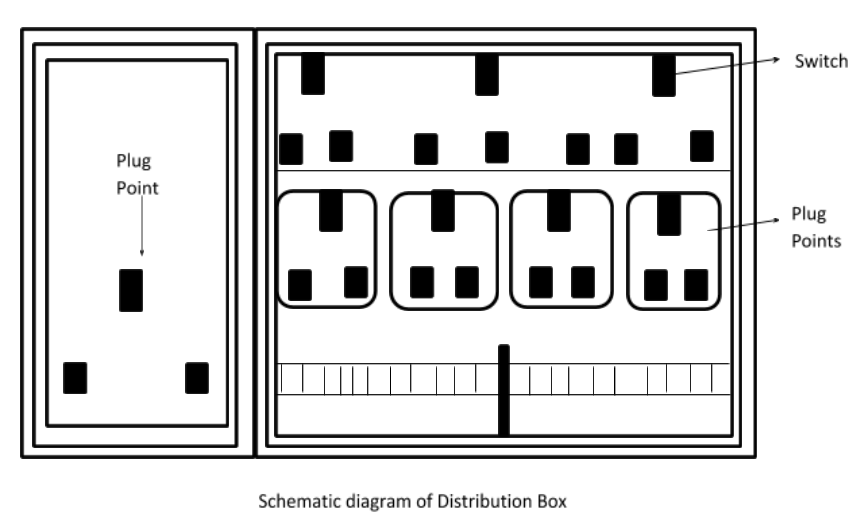
Answer
432.6k+ views
Hint: A distribution box is also known as a panel board. It is a component of an electricity supply system. The main current comes to the distribution box and then it gets distributed among all the components connected to it.
Complete answer:

Distribution board is the main power supply system in domestic and commercial use. The main cable of current comes into the distribution box and then through breakers it gets distributed in the secondary components eg. - Fans, bulbs etc.
In the distribution box there is a component fuse. Fuse does not allow extra current to pass through the circuit. In cases when there is extra current the fuse breaks the circuit and shuts down the flow of current. In this way it saves all the devices or appliances connected in the circuit. So the distribution box prevents any kind of danger and saves the house.
During the installation of the distribution box there should not be any kind of error and there should be enough space for all the wires. A good quality distribution box has a long life and it ensures the safety of devices and house. Distribution box in domestic electric circuits provides isolation between appliances and allows them to work properly.
Result- from above explanation; we see that the distribution box provides isolation between sets of appliances and improves reliability.
Note: Distribution boxes are not only used in domestic means but for industrial purposes also. Following are some types of distribution boxes that are used in industries:
1. Motor Control Centers (MCCs)
2. User friendly Human Machine Interface (HMI)
3. Industrial Hydraulic Control Panels
4. Operator Panels
5. Programmable Logic Controller (PLC) Panels
6. Industrial Hydraulic Control Panels
Complete answer:

Distribution board is the main power supply system in domestic and commercial use. The main cable of current comes into the distribution box and then through breakers it gets distributed in the secondary components eg. - Fans, bulbs etc.
In the distribution box there is a component fuse. Fuse does not allow extra current to pass through the circuit. In cases when there is extra current the fuse breaks the circuit and shuts down the flow of current. In this way it saves all the devices or appliances connected in the circuit. So the distribution box prevents any kind of danger and saves the house.
During the installation of the distribution box there should not be any kind of error and there should be enough space for all the wires. A good quality distribution box has a long life and it ensures the safety of devices and house. Distribution box in domestic electric circuits provides isolation between appliances and allows them to work properly.
Result- from above explanation; we see that the distribution box provides isolation between sets of appliances and improves reliability.
Note: Distribution boxes are not only used in domestic means but for industrial purposes also. Following are some types of distribution boxes that are used in industries:
1. Motor Control Centers (MCCs)
2. User friendly Human Machine Interface (HMI)
3. Industrial Hydraulic Control Panels
4. Operator Panels
5. Programmable Logic Controller (PLC) Panels
6. Industrial Hydraulic Control Panels
Recently Updated Pages
Who among the following was the religious guru of class 7 social science CBSE

what is the correct chronological order of the following class 10 social science CBSE

Which of the following was not the actual cause for class 10 social science CBSE

Which of the following statements is not correct A class 10 social science CBSE

Which of the following leaders was not present in the class 10 social science CBSE

Garampani Sanctuary is located at A Diphu Assam B Gangtok class 10 social science CBSE

Trending doubts
A rainbow has circular shape because A The earth is class 11 physics CBSE

Fill the blanks with the suitable prepositions 1 The class 9 english CBSE

Which are the Top 10 Largest Countries of the World?

How do you graph the function fx 4x class 9 maths CBSE

The Equation xxx + 2 is Satisfied when x is Equal to Class 10 Maths

Give 10 examples for herbs , shrubs , climbers , creepers

Change the following sentences into negative and interrogative class 10 english CBSE

Difference between Prokaryotic cell and Eukaryotic class 11 biology CBSE

Why is there a time difference of about 5 hours between class 10 social science CBSE




